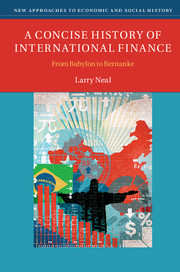Book contents
- Frontmatter
- Contents
- List of figures
- List of boxes
- List of tables
- Preface
- 1 Introduction
- 2 Distant beginnings: the first 3,000 years
- 3 The Italians invent modern finance
- 4 The rise of international financial capitalism: the seventeenth century
- 5 The “Big Bang” of financial capitalism: financing and re-financing the Mississippi and South Sea Companies, 1688–1720
- 6 The rise and spread of financial capitalism, 1720–1789
- 7 Financial innovations during the “birth of the modern,” 1789–1830: a tale of three revolutions
- 8 British recovery and attempts to imitate in the US, France, and Germany, 1825–1850
- 9 Financial globalization takes off: the spread of sterling and the rise of the gold standard, 1848–1879
- 10 The first global financial market and the classical gold standard, 1880–1914
- 11 The Thirty Years War and the disruption of international finance, 1914–1944
- 12 The Bretton Woods era and the re-emergence of global finance, 1945–1973
- 13 From turmoil to the “Great Moderation,” 1973–2007
- 14 The sub-prime crisis and the aftermath, 2007–2014
- References
- Index
1 - Introduction
Published online by Cambridge University Press: 05 October 2015
- Frontmatter
- Contents
- List of figures
- List of boxes
- List of tables
- Preface
- 1 Introduction
- 2 Distant beginnings: the first 3,000 years
- 3 The Italians invent modern finance
- 4 The rise of international financial capitalism: the seventeenth century
- 5 The “Big Bang” of financial capitalism: financing and re-financing the Mississippi and South Sea Companies, 1688–1720
- 6 The rise and spread of financial capitalism, 1720–1789
- 7 Financial innovations during the “birth of the modern,” 1789–1830: a tale of three revolutions
- 8 British recovery and attempts to imitate in the US, France, and Germany, 1825–1850
- 9 Financial globalization takes off: the spread of sterling and the rise of the gold standard, 1848–1879
- 10 The first global financial market and the classical gold standard, 1880–1914
- 11 The Thirty Years War and the disruption of international finance, 1914–1944
- 12 The Bretton Woods era and the re-emergence of global finance, 1945–1973
- 13 From turmoil to the “Great Moderation,” 1973–2007
- 14 The sub-prime crisis and the aftermath, 2007–2014
- References
- Index
Summary
Someday you guys are going to need to tell me how we ended up with a system like this … we're not doing something right if we're stuck with these miserable choices.
Ever since the financial crisis of 2008, doubts have been raised about the future of capitalism. Certainly, seven years of doubtful recovery from the recession of 2007 and then another recession in 2012 in several European countries generated pessimism about the ability of capitalist economies to deal effectively with the persistent instability of the global financial system. At the heart of this pessimistic outlook is a deeper concern over the perils of international finance, compounded by confusion over the proliferation of exotic financial products marketed by hedge funds, venture capitalists, and assorted niche firms that make up the “shadow banking” community. No wonder new studies appear almost daily that try to explain to the wider public, as well as overwhelmed policy makers, what went wrong and what should be done now and in the future to avoid a repeat disaster. As President Bush remarked to his top economic policy makers, Henry Paulson, US Secretary of the Treasury, and Ben Bernanke, chairman of the Federal Reserve System of the US, at the height of the crisis in September 2008, “Someday you guys are going to need to tell me how we ended up with a system like this … we're not doing something right if we're stuck with these miserable choices.”
This book joins a long list of historical works designed precisely to explain to former President Bush (and the rest of us) just how we ended up “stuck with these miserable choices.” Most studies to date provide detailed indictments of the apparent perpetrators of the crisis, beginning with the prime movers – variously profligate politicians, indifferent regulators, or opportunistic financiers – then move on to the propagators of the crisis – rampant greed, ignorance, or indifference of the general public. Few note the international elements; most prefer to focus outrage on the villains near at hand or, most persuasively, on the US with its complex financial system and overwhelming wealth at the center of the international financial system since the Second World War.
- Type
- Chapter
- Information
- A Concise History of International FinanceFrom Babylon to Bernanke, pp. 1 - 14Publisher: Cambridge University PressPrint publication year: 2015

